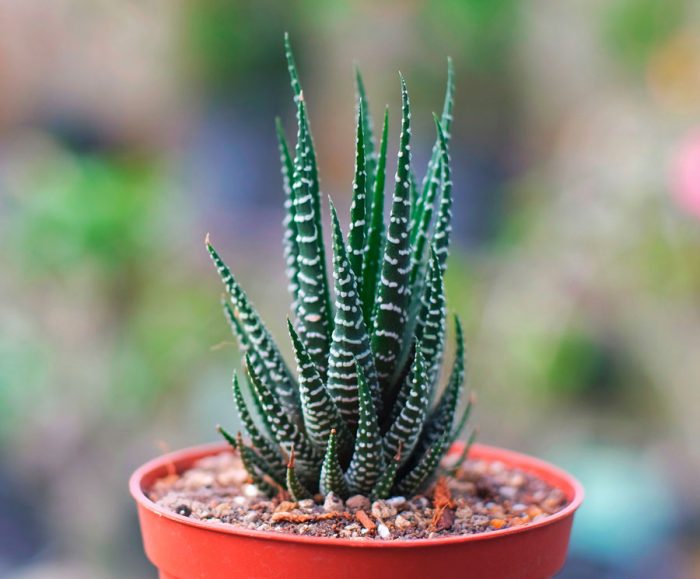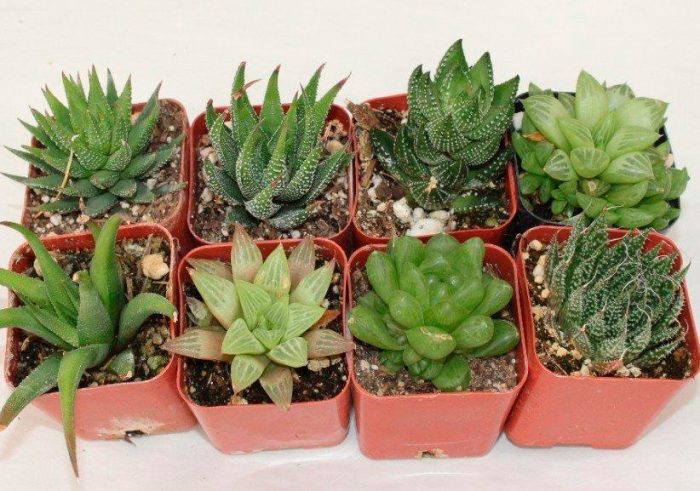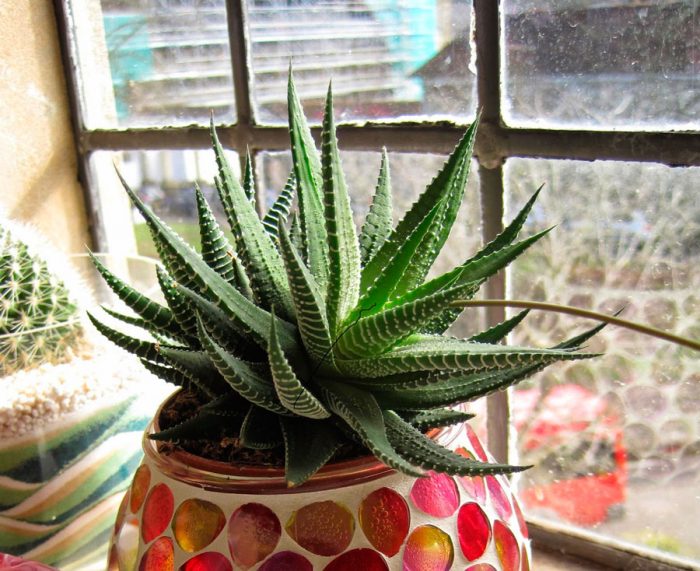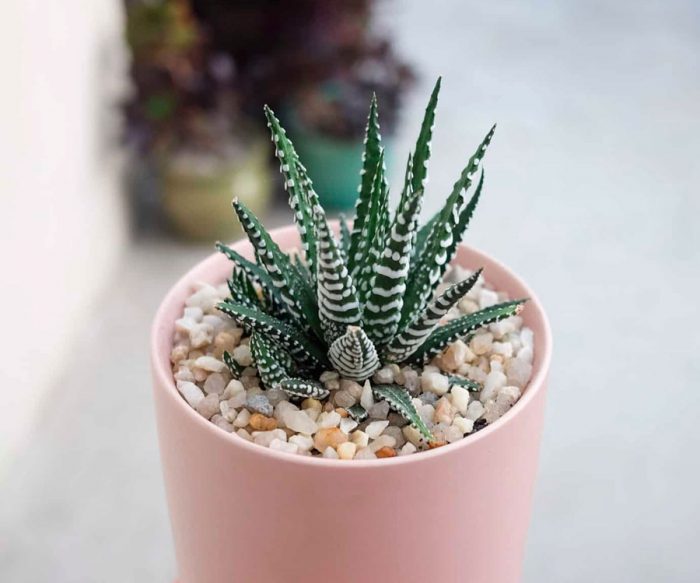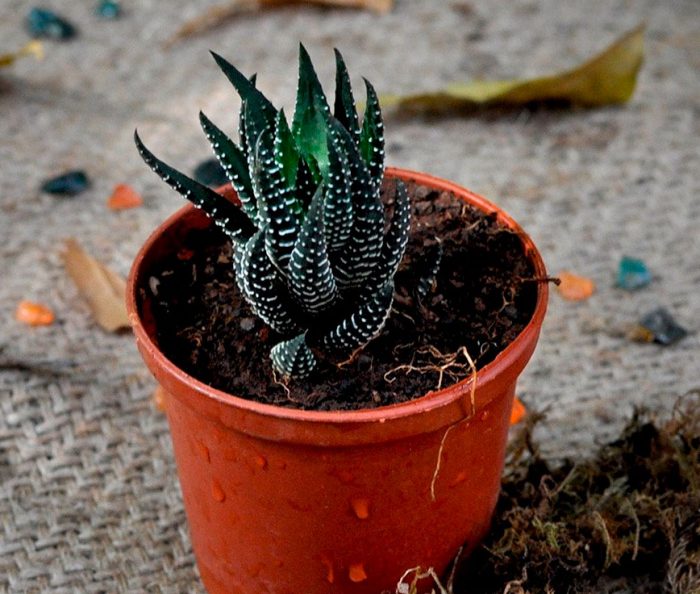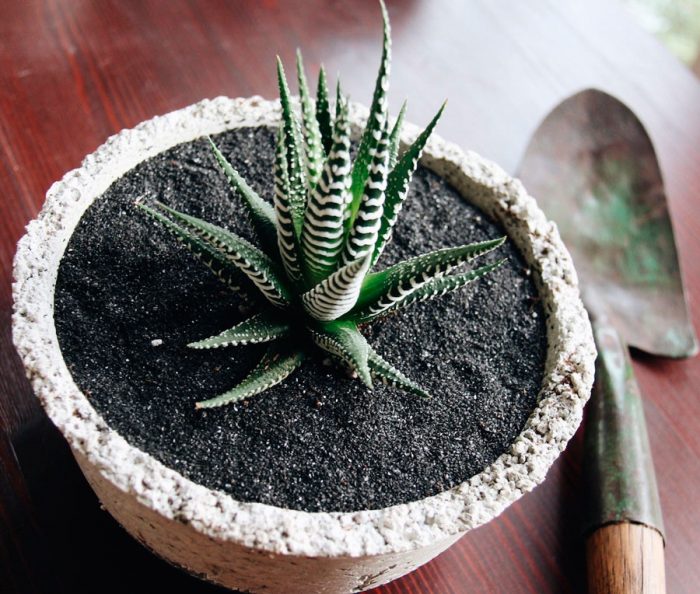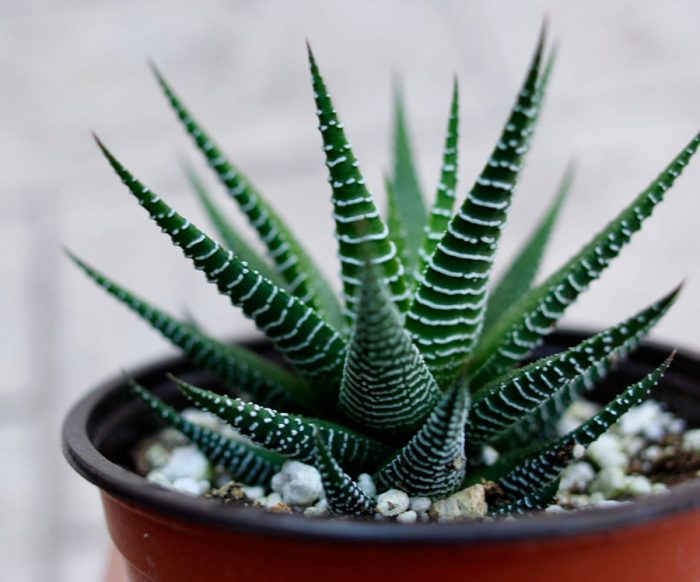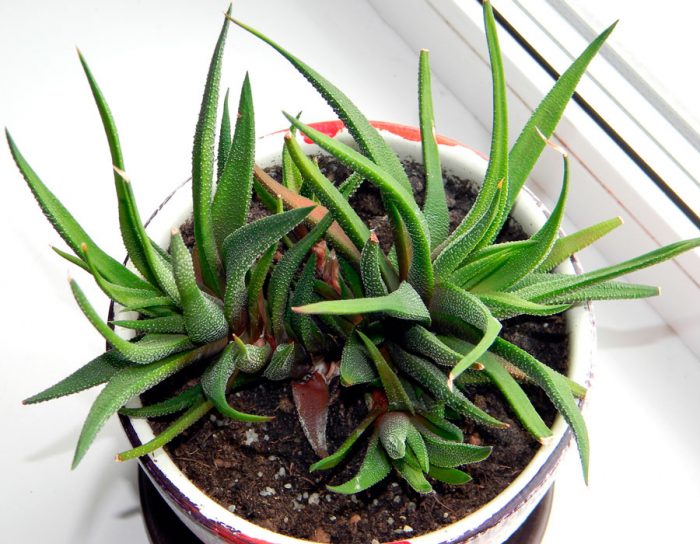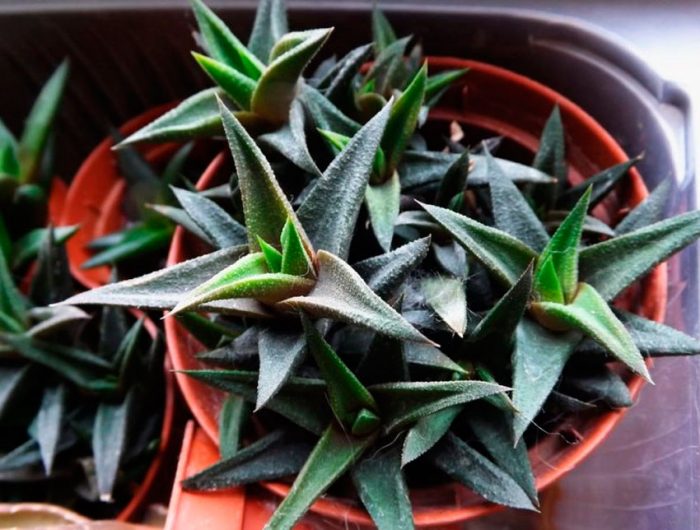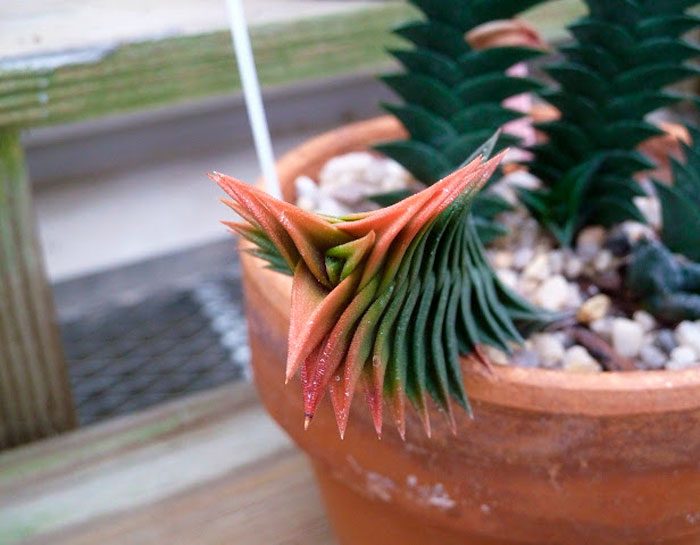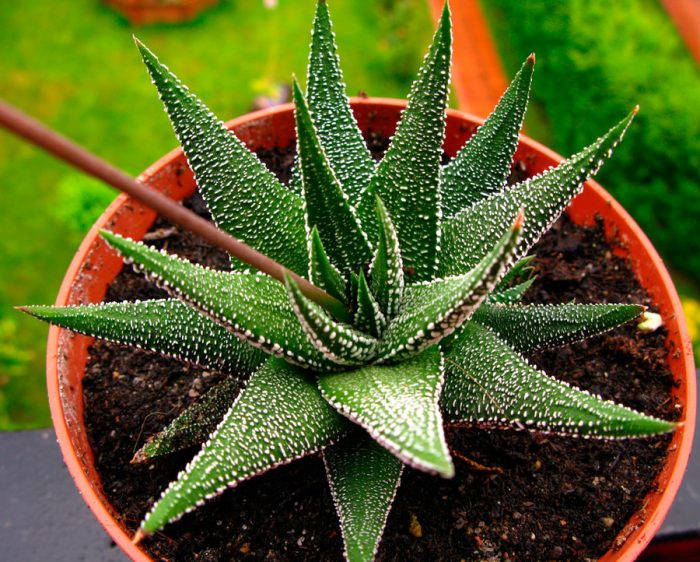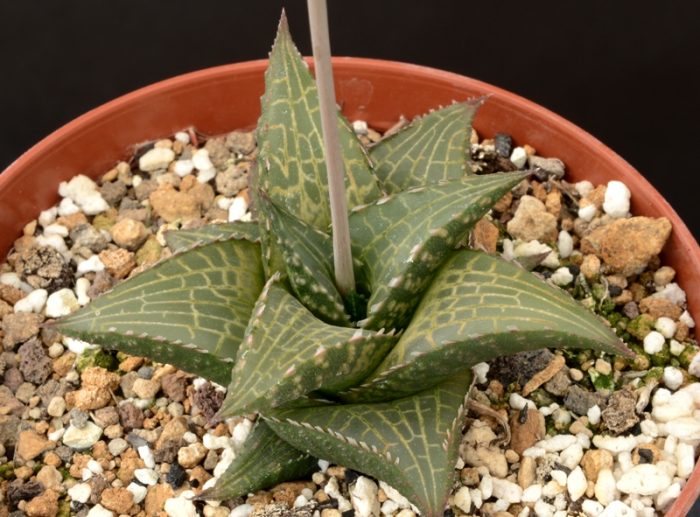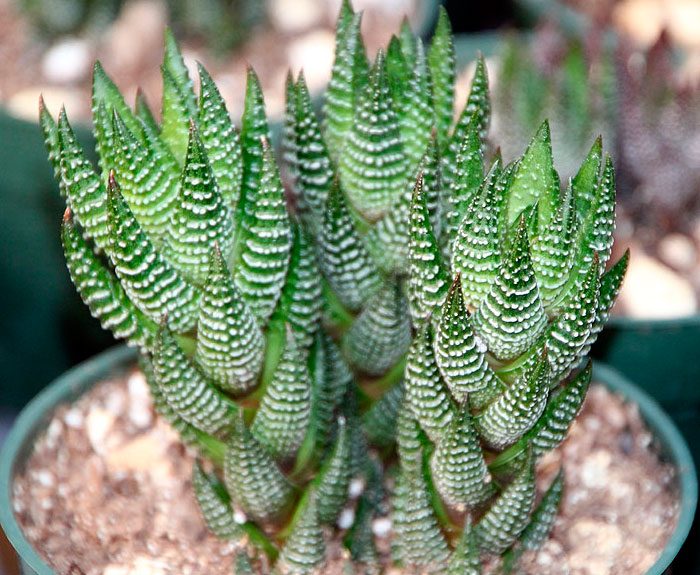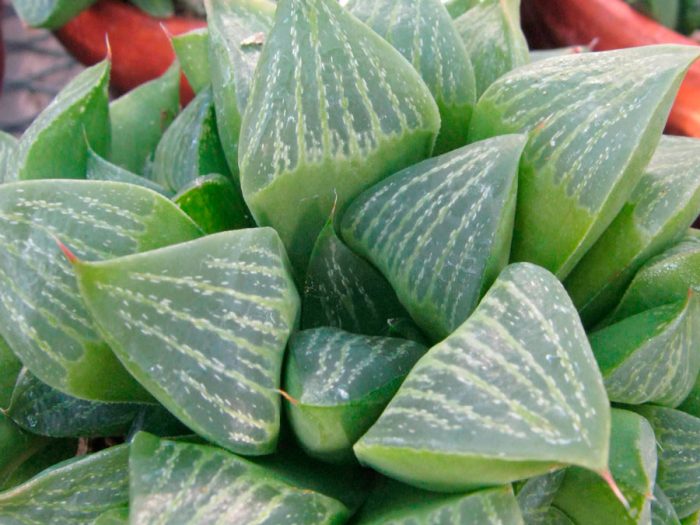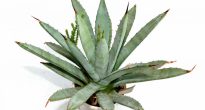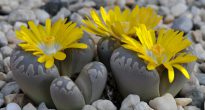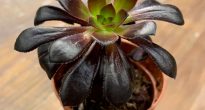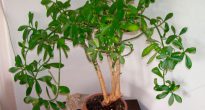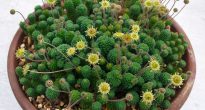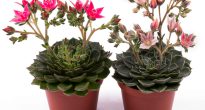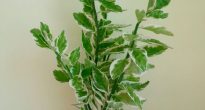The plant haworthia (Haworthia), belonging to the subfamily of Asphodeloids, is represented by miniature and dwarf herbaceous succulents. In the wild, they can be found in South Africa. Such a succulent was named Haworthia in honor of Adrian Haworth, who was an English botanist, it was he who determined the place of this plant in the classification.
As a rule, fleshy leaf plates of a dark green color form rosettes at ground level, but some species have a fairly short stem. The plant is able to accumulate liquid in the thickening of the leaf plates, where it is located in reservoirs. A succulent needs moisture in case of a prolonged dry period. The edge of the foliage is jagged, smooth, or there are spines on it. In some species, there are convex white tubercles on the surface of the leaf plates. Often, a large number of side shoots appear on the bushes. Small white flowers have no decorative value.
Content
Brief description of cultivation
- Bloom... This succulent is an ornamental deciduous plant.
- Illumination... Sunshine, suitable for growing windows of east, south or west orientation. Species in which the foliage has a monochromatic color can be removed in a light partial shade on hot summer days.
- Temperature regime... Grows well at normal room temperature.
- Watering... During the growing season, water should be sparingly, immediately after the top layer of the soil mixture dries well. If in winter the bush has entered a dormant period, then the number of watering is reduced to 1 time in 4 weeks.
- Air humidity... Any level of humidity is suitable.
- Fertilizers... You need to feed in April – August 1 time in 4 weeks, for this use a complex fertilizer for cacti, while the concentration of the solution should be 2 times less weak than recommended in the instructions attached to the tool.
- Dormant period... Not expressed.
- Transfer... Young bushes should be transplanted once a year, and adults - in spring, once every 3 years.
- Reproduction... Most often vegetative, by separating daughter outlets.
- Harmful insects... Mealybugs and scale insects.
- Diseases... Due to waterlogging or when liquid enters the outlet, the plant begins to rot.
Growing rules
To grow a spectacular Haworthia bush on your windowsill, you must adhere to the agrotechnical rules of this culture:
- Windows of western, southern and eastern orientation are perfect for growing it, however, the flower must be protected from the scorching rays of the sun.
- In the spring and summer, watering should be moderate. In winter, the plant rests, so it must be removed to a cool place (from 10 to 12 degrees), while watering must be carried out 1 time in 4 weeks.
- It is necessary to transplant the bush every year, for this they take a not very deep and wide container, at the bottom of which a good drainage layer should be made.
- For planting, you need to use a soil mixture consisting of leaf and turf soil (1: 1), while adding 30 percent of brick chips or small gravel to it.
Home care for haworthia
Haworthia has a very attractive, spectacular appearance, but despite this, it is undemanding. In this regard, everyone can grow such a succulent in their home, you just need to know how to properly care for it.
If the bush grows on a windowsill well-lit by the sun, then in extreme heat it should be transferred to a small partial shade, and if possible, then taken out to the terrace or a shaded balcony. Since this flower is a succulent, any humidity is suitable for growing. The room in which the haworthia grows needs to be ventilated regularly both in summer and winter.
The water used for irrigation should be well-settled and soft. When watering, you just need to slightly moisten the top layer of the substrate in the container, since this succulent needs very little water. In summer, the bush is watered immediately after the top layer of the substrate dries out. If in winter it is in a cool room (from 10 to 12 degrees), then it needs to be watered only once every 4 weeks, but if the flower at this time grows at temperatures above 18-20 degrees, then as a rule, watering is carried out 1 once every fortnight. It is necessary to pour water in such a way that it cannot get into the center of the outlet, as this may cause rot.
Haworthia flowers have no decorative value. In this regard, as soon as the peduncles appear, it is recommended to remove them, as a result, the bush will not waste its energy on flowering.
Top dressing haworthia
In the period from April to August, it is recommended to carry out systematic feeding of this succulent, do it once every 4 weeks. For this, fertilizer is used for cacti, while the concentration of the solution should be 2 times less than it is written in the instructions. Experienced flower growers advise adding fertilizer to the water for irrigation. In autumn, the succulent is stopped feeding.
Transfer
A haworthia transplant is carried out when necessary, for example, if the container becomes very small. As a rule, young specimens are transplanted annually, and adults - once every 2 or 3 years. For planting, you should choose a not very large, low capacity, which should be wide. If the pot is too deep, then because of this, stagnation of liquid will be observed in the root system. For planting, you can purchase a ready-made soil mixture for cacti, but you should add a small amount of small expanded clay and clay to it. Expanded clay is able to absorb excess water with excessively abundant watering. Make sure to make a good drainage layer at the bottom of the pot. In principle, planting and replanting haworthia is very simple and even a beginner can handle it.
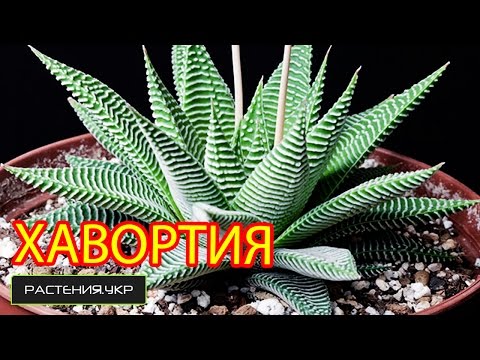

Watch this video on YouTube
Reproduction of Haworthia
Cuttings
If the side rosette of the Haworthia has already developed roots, it should be carefully separated from the parent bush and immediately planted in a pot filled with a moistened substrate. In the case when cuttings with two or three leaf plates that do not have roots were separated, the cut site will need to be treated with wood ash, after which they are dried for several days, and then planted for rooting in moistened sand. After they have formed roots, they are transplanted into a pot filled with a substrate. A leafy stalk needs the same procedure. After pruning, it is left to dry in the open air for several days, and then planted for rooting in sand or loose substrate. Until the roots grow, you do not need to water the substrate in the pot, you just need to moisten it a little from the sprayer. The container should not be covered on top with either a film or glass, the fact is that in such greenhouse conditions there is a high probability that the stalk will rot. Spring is good for breeding.
How to propagate by seeds
Haworthia seeds are distributed on the surface of a loose substrate or moistened sand, the crops are covered with glass or film on top, then the container is removed to a well-lit and warm (20 to 25 degrees) place. But it must be borne in mind that the seed has an extremely low germination rate, while growing haworthia from seeds for a very long time. In this regard, flower growers prefer to propagate this plant vegetatively.
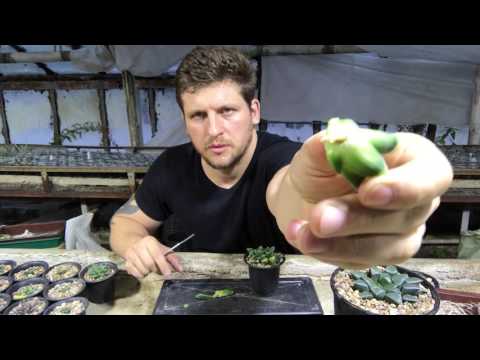

Watch this video on YouTube
Types of haworthia with photos and names
Haworthia striped
Such a perennial plant has no trunk. The bush includes several basal dense rosettes, consisting of original thick lanceolate leaf plates, on the seamy surface they have convex stripes of white color, while the front side is smooth and green. In length, leaf plates reach 50 mm, and their width is 10–15 mm.
Haworthia drawn
This species is similar to striped haworthia, but this plant is less impressive. On its leaf plates there are convex points of green or white color. The lanceolate leaf plates are directed upwards, their length is about 70 mm, and their width is up to 15 mm.
Haworthia meandering
This species is also called sinuous aloe. Haworthia has a not very high stem, which reaches a height of about 15 centimeters. The length of dark green leaf plates is about 25 mm, their lower surface is convex and there are small warts on it.
Haworthia sticky
The height of the bush varies from 10 to 20 centimeters. Oval small leaf plates are placed in 3 rows, they are erect and have a bent tip, their length is 25 mm, and their width is 15 mm.
Haworthia navicular
Scaphoid glossy fleshy leaf plates have a window on the surface, they are part of the basal rosette, which reaches 10 centimeters in diameter, and in the case when there are lateral shoots, the diameter will be 15–20 centimeters.
Haworthia pearl
It is a herbaceous perennial succulent with virtually no stem. The basal rosette is formed from rigid leaf plates of a pointed-oval shape, their length is 70–80 mm, and their width is up to 25 mm. The green leaf blades have round bulges of pearl-white color on both surfaces, they are similar to pearls and make the bush very effective.
Haworthia chess
Triangular thick sheet plates have a serrated edge, they are part of small rosettes. On the front surface of the foliage there are streaks of white color, which form a mesh, while on the seamy side there are warts.
Haworthia Reinwardt
The elongated rosette is formed from fleshy leaf plates of a triangular shape, their width is 10-15 mm, and their length is 35 mm.The seamy surface of the foliage is covered with rows of white protuberances located longitudinally and transversely, while they clearly stand out against the background of a dark plate. This species has a kind of "zebrin": its warts are brighter, while the foliage is larger, and the bush looks extremely impressive. A young bush has an erect stem, but after a while it bends and lies down.
Haworthia retuza, or blunt
Hard fleshy triangular leaf plates are bent in the upper part, they reach 50 mm in length, on their surface there are transparent windows and streaks of light color. Foliage color can range from greenish brown or greenish red to green. There are low-chlorophyll and variegated forms. The variety "Gigant" has very large leaf plates, while the upper part of them is dissected by veins.
Such a culture can get sick only when agrotechnical rules are violated. If you follow the rules for growing such a crop, then the plant will never get sick.
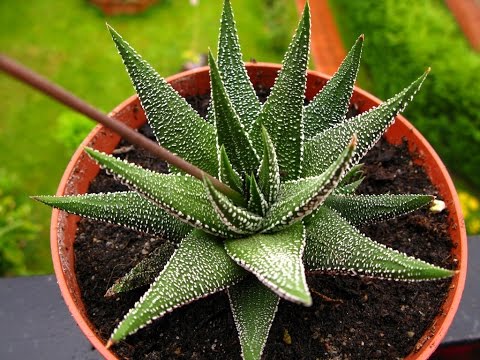

Watch this video on YouTube

